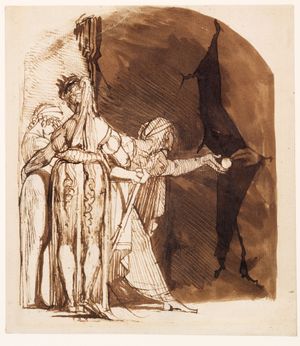Author: Aubrey Minshew, Museum Specialist, Truhlsen-Marmor Museum of the Eye®
The word “ophthalmology” comes to us from Greek. It’s a combination of ὀφθαλμός (“ophthalmos” meaning eye) and -λoγία (“-logia” meaning study), so it is literally “the study of eyes.” As it happens, the ancient Greeks gave us more than our modern word for eye medicine; they also left us collections of mythology and literature that feature eye symbolism. So, as we do in the Signs & Symbols exhibit, let’s decode some of these ancient Greek eye myths and legends.

A Greek postage stamp from the museum’s collection bearing eye symbols on pottery
In ancient Greek myths, there are creatures with an abnormal number of eyes.— Many of these characters are depicted as having only one eye, but there are also instances where a character has many. The most well-known of these creatures are the Cyclopes (Κύκλωπες) — giants with only one eye in the center of their foreheads. Hesiod’s Theogony (c730–700 BCE) is an epic poem detailing the birth of the Greek gods. It describes the Cyclopes as three “wheel-eyed” giants — meaning one eye as large as a wheel — who are roaming the earth before Zeus and the other Greek gods are born. They eventually become the forgers of Zeus’s thunderbolts. A specific Cyclops named Polyphemus (Πολύφημος) also appears in Homer’s Odyssey (c800–701 BCE). In the story, Odysseus and his crew encounter Polyphemus on their journey back from the Trojan War. Polyphemus is shown as large and brutish, capturing and killing men in Odysseus’s crew. Odysseus is only able to overpower him by getting Polyphemus intoxicated and gouging out his one large eye with a sharpened log. Having duped Polyphemus, Odysseus and remaining crew then escape, tied to the undersides of his sheep, and are able to resume their journey toward Ithaca.

A bust of Polyphemus at the Colosseum in Rome
Another singular eye appears in the story of the hero Perseus. This time, the one eye is shared among three women. The Graeae or Graiai (Γραῖαι) are three semi-divine sisters, often appearing as very old women, who share one eye and one tooth among them. They are daughters of a pair of primordial sea gods and are sisters to the snake-haired Medusa and other Gorgons. In the myth, Perseus, who is the half-divine illegitimate son of Zeus, is sent on a quest to kill Medusa and bring back her head. During this quest, he needs help from the Graeae to find Medusa, so he ends up tricking them into helping him by stealing their shared eye. Eventually, the Graeae give Perseus a pair of winged sandals, a cap that makes him invisible, a sword to slay Medusa, and a magical bag to store her head, all in return for their precious eye.
You may also recognize three sisters sharing an eye from the Disney film Hercules (1997). This movie actually combines the Graeae and the three Fates, who control when souls are sent to the underworld, into one set of characters. The three Weird Sisters in William Shakespeare’s Macbeth (c1606) are also reminiscent of this “three old witches” trope, but they are portrayed with two eyes each.
“Perseus Returning the Eye to the Graiai,” Henry Fuseli, c1790–1800
Not all these mythical creatures are one-eyed, though. The giant Argus Panoptes (Ἄργος πανόπτης) serves as a watchman for Zeus’s often-jealous wife Hera. His nickname, Panoptes or “all-seeing,” is literally a combination of παν (“pan” meaning all) and όπτης (“optes” meaning seeing), which really gives away his primary feature — a head covered in many eyes! The number of eyes that Argus Panoptes has is not usually specific, but the Roman poet Ovid’s Metamorphoses (8 CE) portrays him as having one hundred unique eyes. Because of this, he is uniquely qualified as a watchman. He can see all angles and directions and has the ability to close some eyes to sleep and keep others open, allowing him to stay somewhat awake at all times.
In one myth, the long-suffering Hera is aware that her philandering husband Zeus is interested in a mortal woman. The gods turn this woman, Io, into a white heifer, and Hera sends the all-seeing Argus to guard Io from Zeus’ wandering eye. Zeus cannot be dissuaded, and he has the god Hermes kill Argus so Zeus can be with Io. While this is a sad end for our favorite many-eyed monster, Ovid tells us that we can see the hundred eyes of Argus Panoptes preserved in the pattern of a peacock’s tail.
Argus Panoptes guarding Io in bull form, Pinturicchio, 1492
In all these examples, the different number of eyes relegates these creatures to a strange middle ground. Since both humans and the gods have two eyes, these one-eyed and many-eyed characters are out of the norm, making them magical, yet sometimes monstrous figures. Their numbers of eyes also provide very visible metaphors for these ancient Greek authors: One-eyed creatures like Polyphemus the Cyclops and the Graeae have both literal and figurative gaps in their vision, which allow the heros to trick them. The many-eyed Argus Panoptes is metaphorically observant as a guard and literally observant due to his numerous eyeballs.
Want to learn more about ancient Greek signs and symbols? “Decoding the Eye: Signs & Symbols” will be on display in the museum until Spring of 2024. Have a favorite eye-related myth or legend you’d like decoded? Share it with us on social media at @museumoftheeye on Facebook, Instagram, and X (formerly Twitter) and we might feature it on the blog!